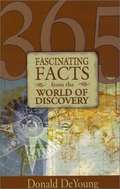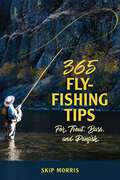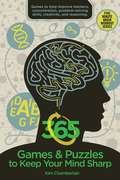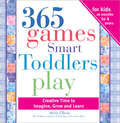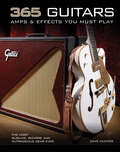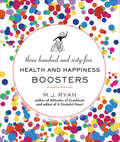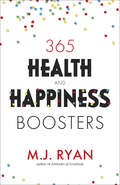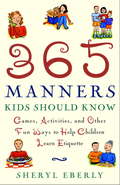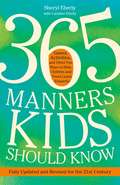- Table View
- List View
365 Fascinating Facts about Jesus
by Robert StrandFrom over 100 sources, popular gift book author Robert Strand has compiled both common and little-known facts about Jesus Christ. The Jesus that Strand uncovers is definitely the Christ of the Gospels, and the political, cultural, and religious times in which He lived are brought to life in this terrific book. Read about the traditions that Jesus grew up with, the historical facts about his birth, death, and resurrection, and man's ideas about Him vs. reality. Great as a reference book or gift, this collection of fascinating facts serves to illuminate "God With Us." SAMPLE FACTS: What was Jesus' last name? According to Jewish tradition, one's last name was always determined by the father's given name. So the Lord's complete name would have been "Yeshua Ben Yosef." Old Testament Prophecies Contained in the Old Testament, there are more than 300 specific prophecies alone that concerned Jesus, the promised coming Messiah. These were written from 450 to more than 2,000 years before his birth. It's been mathematically calculated that the probability of just 8 of the more than 300 prophecies being fulfilled by chance is 1 in 1017. It is beyond the realm of calculation to figure the probability of all 300-plus coming to pass in one life.
365 Fascinating Facts from the World of Discovery
by Donald B. DeYoungAn engaging look at significant discoveries through the centuries, mostly geared around science and invention. Dr. DeYoung uses his astronomy background as a basis for sharing many significant events down through the years, and adds to the mix with facts related to many different areas of science. This compilation of short facts will thrill trivia enthusiasts and are designed to help the reader commit them quickly to memory.
365 Fly-Fishing Tips for Trout, Bass, and Panfish
by Skip MorrisFly fishers are always looking for useful, reliable, and trustworthy tips to improve their fishing. Veteran author and fly fisherman Skip Morris gives a year&’s worth of practical tips for taking trout, large and smallmouth bass, and panfish from streams and lakes in a handy, easy-to-read and grasp format. Tips include info on casting, finding fish, rigs and strategies for using them, techniques, the right tackle, knots, hooking, playing and landing fish, releasing, fishing lingo and terms, and staying safe. For further help, the tips are illustrated with instructive line drawings and color photos.
365 Games & Puzzles to Keep Your Mind Sharp (Brain Workout)
by Kim ChamberlainShort and Fun Activities Designed to Train and Maintain Your Brain Taking care of your brain is just as beneficial as taking care of the rest of your body--research has shown that training games help improve memory, concentration, problem-solving skills, processing speed, creativity, and reasoning. 365 Games & Puzzles to Keep Your Mind Sharp provides a year’s worth of challenging mental activities to keep your brain sharp and flexible. Chamberlain’s fresh new installment uses the same format as The Five-Minute Brain Workout: a variety of games and puzzles, each with ten examples that increase in difficulty as you work through the book. This collection includes some fan favorites along with many new and exciting puzzles that will further develop your skills. 365 Games & Puzzles to Keep Your Mind Sharp is perfect for lovers of word and language games and puzzles, providing enough short, sharp exercises for a year’s worth of fun and brain stretching.
365 Games Smart Toddlers Play
by Sheila Ellison365 Games Smart Toddlers Play will help you make the best of the time you and your toddler share, every day of the year. Each day with your toddler brings new experiences for them and new opportunities for you to teach, share and grow closer to each other. Bestselling parenting author Sheila Ellison fills each page with fun, practical ways to create and enhance those special everyday moments. Perfect for: Parents Grandparents Child-care providers Baby-sitters.
365 Goddess: A Daily Guide To the Magic and Inspiration of the Goddess
by Patricia TelescoGoddess wisdom for every day of the yearBring life-affirming magic and empowerment into every day of your life with this unique and useful guide to the goddess. Through the ages, people have celebrated the role of goddesses in maintaining the fl
365 Golf Tips & Tricks From the Pros
by Jay MorelliA golf tip a day helps keep the bogeys away! This handy, illustrated guide contains the very best advice from more than 60 PGA teaching pros, compiled by a PGA Teacher of the Year. Designed to improve the long game, chip and pitch shots, sand play, putting, physical conditioning, and more, these hints are what youd learn if you paid thousands of dollars at a golf school, country club, or university. Color photos by a Sports Illustrated photographer clearly illustrate each skill! Its a must-have for every golf enthusiast.
365 Gratefuls: Celebrating Treasures, Big and Small
by Hailey Bartholomew Andrew BartholomewWhat are you grateful for?That is precisely the question that Hailey Bartholomew asked herself every day for a year. Struggling with depression, she reached out for help and received life-changing advice: Find something every day that you are grateful for.Embracing her assignment, Hailey used her talents as a photographer to put a twist on the exercise, taking pictures of her “gratefuls” and becoming more aware that her depression was lifting in the process. 365 Gratefuls is a collection of photographs recounting Hailey’s transformation from depression to an unhindered appreciation of the world around her, combined with stories and images from many others who have encountered the effects of gratitude. This uplifting book will inspire you to look at the world with new eyes, emphasizing gratitude over anxiety in everyday moments.
365 Guitars, Amps & Effects You Must Play: The Most Sublime, Bizarre and Outrageous Gear Ever
by Dave HunterGuitarists love guitars. Few own just one, and most are dreaming of their next acquisition. To help them out, here is the ultimate bucket list of guitars—plus guitar amps and various guitar effects—that aficionados must play.Included are the classics, such as the great Fender guitars, the Stratocaster and Telecaster, and the stylish Gibson Les Paul. Included as well are the dream creations—masterpieces from D’Angelico and Gretsch. And then there are the weird guitars—the outrageous, rare, and so-strange-they’re-cool, and your beloved childhood guitar that you first learned on. Included as well are the guitar amps, from vintage to current, rare to essential, plus the stompboxes, foot pedals, and guitar effects that you simply have to take for a ride.Each instrument is profiled along with a short description of its history, technical features, and what it’s like to play.Photographs and rare memorabilia add the crowning touch, making this the perfect impulse buy or giftbook for any and all guitarists.
365 Happy Bedtime Mantras: Improve Your Sleep, Release Stress, and Enjoy Your Dreams (Happy Bedtime Mantras #1)
by Shannon KaiserFrom &“one of the freshest voices in mental health and wellness&” (Marci Shimoff, New York Times bestselling author), a year&’s worth of nightly practices to help you establish healthy sleep habits so that you can relax, de-stress, and dream deeply for a better well-being. Millions of Americans are struggling with sleep disorders or insufficient sleep, putting them at risk for numerous other health issues. For them, every night can feel like a losing battle. Now, 365 Happy Bedtime Mantras seeks to reverse the epidemic of poor sleep by helping you balance both the body and mind with self-love and relaxation-promoting mantras, meditations, and bedtime rituals. Whether you want to improve your quality of life with better sleep, effectively transform your evening routines, practice more self-care and self-love, or simply add more mindfulness moments to your life, you will find what you need in this wonderous book.
365 Health and Happiness Boosters
by M. J. RyanWe all want to be happy, but according to research, two-thirds of us don't know how to be happy. Most of us think happiness resides in the things we don't have: the dream house, the perfect mate, the ideal job, the supermodel's body. As proof that possessions don't, in fact, increase the happiness quotient, a study conducted in 1957 and 1992 asked people whether they were happy with what they had in life. In both polls, roughly 30 percent said yes, despite the fact that the standard of living had increased dramatically over the years. This book rests on the assumption that you can be happier, no matter who you are or what your challenges. Rather than delivering abstract theory, it offers 365 concrete things to do, to try, or to reflect on, in order to experience happiness. Some are attitudes that we can change to create more happiness overall in our lives; others are specific things we can do to lift our spirits in the moment; still others are behaviorial modifications or nutritional supplements we can try. And while some are lighthearted and others quite serious, they all will have a positive effect on your mind, body, and spirit.
365 Health and Happiness Boosters
by M. J. RyanThe Pursuit of Happiness Starts Within“By giving us daily happiness activities that touch our hearts and souls, M.J. Ryan empowers each of us to experience the joy of living.” —Jackie Waldman, author of The Courage to GiveDaily tasks to improve how you feel —mind, body, and spirit —from the bestselling author of Attitudes of Gratitude.From M.J. Ryan, bestselling author and international expert on change and personal fulfillment, comes 365 Health & Happiness Boosters to help in your pursuit of happiness, so you can choose to be happy no matter who you are or the challenges you face.Develop an attitude of gratitude. When a person thinks happy thoughts, those thoughts project outward and that feeling transfers to others. One third of the population knows the secret to happiness is an inside job —not contingent on possessions, status, or even life circumstances, and research shows it leads to better health. We can all choose to be happy. In 365 Health & Happiness Boosters, a book of daily reflections, M.J. Ryan lays a path for the pursuit of happiness by employing a wide variety of spiritual, emotional and practical suggestions.Discover 365 ways to experience happiness. Some of the tasks are lighthearted, others quite serious. They all have a positive effect and contribute to inner peace. Learn to:Cultivate contentment and change your outlook on the art of happinessLift your spirit in the moment and build inner peaceAddress eating habits and develop better sleeping patternsImprove interactions with others through meditating on happy thoughts and doing random acts of kindnessIf you enjoyed The Happiness Advantage, How Happiness Happens, the Happiness Workbook, or other M.J. Ryan books such as Attitudes of Gratitude or Random Acts of Kindness Then & Now, then 365 Health & Happiness Boosters should be your next read.
365 Ideas For Recruiting, Retaining, Motivating And Rewarding Your Volunteers: A Complete Guide For Nonprofit Organizations
by Sunny Fader Brian BandtAccording to recent statistics by the U.S. Department of Labor, 26.7 percent of the population volunteers. Unfortunately, while the population is increasing, the percentage of Americans who volunteer is decreasing each year. What this means is that you must hang onto and keep your volunteers happy and coming back, perhaps bringing new volunteer recruits with them. This new book is packed with hundreds of simple and inexpensive ways to motivate, challenge, and reward your volunteers. Volunteers today need constant reinforcement and recognition, and here is how to do it. With real life, proven examples and case studies from actual nonprofit organizations, you can use this book daily to boost morale and productivity and find fundraising activities. This is your opportunity to build an organization that people love to volunteer, and you can do so by using these quick, effective, humorous, innovative, and simply fun solutions. Make your organization a happy place to volunteer, and reap the benefits. Atlantic Publishing is a small, independent publishing company based in Ocala, Florida. Founded over twenty years ago in the company president’s garage, Atlantic Publishing has grown to become a renowned resource for non-fiction books. Today, over 450 titles are in print covering subjects such as small business, healthy living, management, finance, careers, and real estate. Atlantic Publishing prides itself on producing award winning, high-quality manuals that give readers up-to-date, pertinent information, real-world examples, and case studies with expert advice. Every book has resources, contact information, and web sites of the products or companies discussed.
365 Inspirations For A Great Life
by Lynda FieldAccessible, simple yet highly effective tips and exercises to enable you to become the person you want to be and bring positive energy into your life. 365 Ways to Feel Fantastic provides daily strategies to create the reality you want, overcome obstacles and realise the powerful effects of your own thoughts. In this way you can transform yourself, your relationships, your body, your self image, your bank balance and your spiritual context. Written with humour and insight, this book sets out the small steps that will inspire you to make quantum leaps towards making your life fantastic.
365 Manners Kids Should Know: Games, Activities, and Other Fun Ways to Help Children Learn Etiquette
by Sheryl EberlyHave you ever cringed at the sight of your four-year-old waltzing through the neighbor's front door without an invitation? Have you ever had to call to apologize when your six-year-old forgot to thank his grandmother for the birthday gift she so lovingly sent? How about the formal dinner for Dad's promotion when your ten-year-old decided that she didn't like the meal she'd ordered, and then refused to eat a thing--making for an uncomfortable evening for you, the other guests, and the waiter? As a parent, you've probably experienced these and many more instances when it seemed that your children had forgotten their manners completely, leaving you frazzled and embarrassed. Sheryl Eberly's365 Manners Kids Should Knowgives clever and insightful advice for the myriad of situations where consideration counts, but is sometimes forgotten. Using her smart one-manner-a-day format, parents, grandparents, and even aunts and uncles can find practical ways to teach basic manners, such as: * How to address elders when being introduced * How to write a thank-you note * The polite way to answer the telephone * How to accept and decline an invitation * What is expected at formal occasions such as weddings, funerals, and religious services Full of role-playing exercises, games, and other activities that parents can do with their children,365 Manners Kids Should Knowhelps parents and other caregivers understand not only what manners to teach, but also how--and at what ages--to present them. Most important,365 Manners Kids Should Knowmakes learning manners fun.
365 Manners Kids Should Know: Games, Activities, and Other Fun Ways to Help Children and Teens Learn Etiquette
by Sheryl EberlyIf you've ever cringed at the sight of your ten-year-old waltzing through the neighbor's front door without an invitation, or struggled to teach your teenager proper "netiquette" for navigating the complicated world of social networks, you know the importance of teaching kids that manners matter. Sheryl Eberly's bestselling 365 Manners Kids Should Know gives clever and insightful advice for the myriad situations where consideration counts, but is sometimes forgotten. This new edition incorporates tips for every aspect of digital communication into her straight-forward format. Using a smart one-manner-a-day organization, parents, grandparents, and teachers alike can find practical ways to teach essential manners like: - When and where it's appropriate to text - How to write a thank-you note - The proper way to handle an online bully - How to behave at events like birthday parties, weddings,and religious services Full of role-playing exercises, games, and other activities that adults can do with children, 365 Manners Kids Should Know explains not only what manners to teach, but also how--and at what ages--to present them. From the Trade Paperback edition.
365 Mary
by Woodeene Koenig-BrickerShe has been called the Blessed Virgin, the Mother of God, the Queen of Heaven, Mother of Perpetual Help, Queen of Peace, and Mother of Mercy. But by any name and in every age, Mary has been the beloeved bringer of solace, hope, and faith to the world. In this lovely giftbook, designed in the popular "365" format, Woodene Keonig-Bricker presents daily words of wisdom from Mary--including miracles, blessings,ectasies, and healings. Drawn from Scripture, legend, and study, 365 Mary offers the world a powerful invitation to prayer, foregiveness, hope, and love.
365 Meditations for Men by Men
by S. D. Sharpe; Christian Coon et alIntroductionMan’s search for meaning is the primary motivation in his life.—Viktor Frankl, Man’s Search for MeaningThere is a longing deep within every man’s heart to discover meaning and purpose in life; to lead a life of significance as opposed to a life of “success”; to live a life of adventure, conquest, and victory; to make a difference and leave a positive, enduring mark on the world. Yet, as Henry David Thoreau observed, “The mass of men lead lives of quiet desperation.” Although Thoreau penned these words more than a century ago, they still ring true today. So many men—including devoted Christian men—wake up one day and realize they are leading lives of quiet desperation, silently “losing themselves” as they strive to meet unrealistic expectations, overcome mounting work and family pressures, and battle unrelenting temptations. These challenges can easily sidetrack men, causing them to lose their spiritual focus.Whether consciously or unconsciously, many men subsequently spend their time and energy and resources searching for significance in pursuits and people and things that can never fully satisfy. Some simply give up on ever finding lasting meaning and purpose in this world. Others find themselves somewhere in between. In any case, the result is often the same: a pervading sense of exhaustion, futility, or hopelessness.Yet there is a remedy to this cultural epidemic, and it is found in reclaiming and living out every man’s true purpose, which is found in God alone. As Saint Augustine wrote, “Thou hast made us for Thyself, O Lord, and our hearts are restless until they rest in Thee.” The apostle Paul expressed it this way: “Everything, absolutely everything, above and below, visible and invisible . . . everything got started in [Christ] and finds its purpose in him” (Colossians 1:16 The Message). 365 Meditations for Men by Men is intended to help men focus on their relationship with God and, consequently, find real meaning and purpose in life. Twelve different Christian men share their reflections on what it means to be a man who seeks to follow Christ each and every day. Drawing upon the lives of men in the Bible as well as their own personal experiences, the writers present timeless truths and valuable life lessons that will speak to men of every age and experience. In addition to offering inspiration and encouragement, they provide counsel on practical matters such as how to · know God;· get your priorities in order;· become spiritually fit;· be holy and righteous;· make a difference;· be equipped;· step up;· take risks;· stand firm;· serve God wholeheartedly. As you make your way through the year (whether you start in January or June), you will be undergirded by a sense of brotherhood—an assurance that you are not alone on this journey. With this confidence, may you boldly and courageously pursue a full and abundant life in Christ!- S. D. Sharpe, editor
365 Meditations for Mothers by Mothers
by Sally D Sharpe; Hilda Davis-Carroll et al365 Meditations for Mothers by Mothers offers a year’s worth of short daily devotional readings written specifically for mothers, by mothers. Twelve different women of faith present a month’s worth of devotions each, providing a rich variety of topics and writing styles. Designed to be used by mothers of all ages and stages, the daily meditations are brief enough to be read in just a few short minutes yet meaningful enough to prompt a longer time of meditation and prayer if desired. Each day’s reading includes a focus Scripture verse, a brief devotion, and a prayer.Sally D. Sharpe is the editor.Writers include: Hilda Davis-Carroll, LeNoir Culbertson, Clare Golson Doyle, Mary Ritzman Ebinger, Leanne Ciampa Hadley, Rebecca Laird, Laura Leigh Parker, Sheron Patterson, Lillian Smith, Stephanie Thompson, Kathleen Turner, Ginny Underwood
365 Meditations for Teachers by Teachers
by Sally D Sharpe; Angela M. Bailey et al365 Meditations for Teachers by Teachers offers a year’s worth of short daily meditational readings written specifically for teachers, by teachers. Four different writers of faith present three months’ worth of meditations each, providing a variety of topics and writing styles. Designed to be used by readers of all ages, each daily meditation is brief enough to be read in just a few short minutes, yet meaningful enough to prompt a longer time of reflection and prayer if desired. Each day’s reading includes a focus Scripture verse, a brief reflection, and a prayer.
365 Meditations for Women by Women
by Various Nell W. Mohney Monica Johnson Cynthia Gadsden Lillian C. Smith Sally, D. Sharpe Anne Hagerman WilcoxThis ebook offers a year's worth of daily devotional readings from twelve different women of faith. This ebook is for women of all ages. Each day's reading includes a focus Scripture verse from a mix of translations, a brief reflection, and a prayer.
365 Meditations for Young Adults
by Sally Sharpe"This book offers a year's worth of short daily devotional readings written specifically for today's young adults. Though this is a diverse group with a variety of needs and interests, they are sojourners together on a common journey-one that includes many similar experiences, stages, and transitions that each of them has been through, is currently going through, or will go through at some time in the future. The young adult years are a time of change and challenge, a time of seeking and searching, a time of exploration and discovery-in short, a time of tremendous opportunity for personal and spiritual growth. As readers make their way through the book, encountering a different writer or team of writers each month, they will find practical and spiritual insights, encouragement, and a sense of camaraderie for the journey."
365 More Ways to Cook Chicken
by Melanie BarnardHere's the book chicken lovers everywhere have been waiting for: the companion volume to the bestselling 365 Ways to Cook Chicken. You can't have too many ways to prepare America's favorite bird, especially when the recipes are all brand-new -- with less fat, the latest ingredients and the most sensational flavors. Best of all, the recipes are quicker and easier than ever.In 365 More Ways to Cook Chicken, you'll find a dish for every occasion and every taste. There are American classics, such as Finger-Lickin' Barbecued Chicken and Old-Fashioned Chicken Pot Pie and international specialties, such as Chicken Cacciatore and Basque Chicken with Tomatoes and Olives. There are chicken snacks, sandwiches, stews, roasts, barbecues and, of course, separate chapters for those perennial chicken favorites: salads (Grilled Chicken Taco Salad, and Caribbean Chicken Salad) and soups (Thai Chicken and Lemongrass Soup, and Sicilian Chicken Soup with Escarole and Pastina). Steamed Moroccan Chicken and Grilled Chicken Fra Diavolo are samples from the "Light and Lean" chapter, which, along with sections on one-pot chicken dishes and especially fast and easy recipes, make this collection invaluable.
365 Nights
by Betsy Thorpe Charla MullerWhen Charla Muller?s husband turned 40, she gave him something memorable. Sex. Every day. For an entire year. The Mullers had a solid marriage and two wonderful children, but over the years sex had fallen low on their to-do list. The lack of intimacy wasn?t causing them to drift apart, exactly, but their connection didn?t seem as great as it could be. Charla decided she couldn?t go on pretending the relationship they once had wasn?t important. The couple would embark on a year of scheduled sex, falling over Tonka trucks and piles of laundry in an effort to make time for each other. There were obstacles along the way (work implosions, faking it) and questions came to light. Will sex every day strengthen a marriage, or reveal the cracks? Pull a couple together or drive them apart? Does good sex (even mediocre sex) make up for things that aren?t so good?
365 Oddball Days in St. Louis Cardinals History
by John SnyderThe St. Louis Cardinals is one of the most successful franchises in National League history. Having won a record ten World Championships, the team has cultivated a huge fan base. 365 Oddball Days in Cardinals History combines easy-to-browse baseball trivia with a never-out-of-date annual. It delivers historical and statistical information in quick nuggets, elevating this collection to the perfect water cooler book or bathroom reader for Cardinals fans everywhere.

